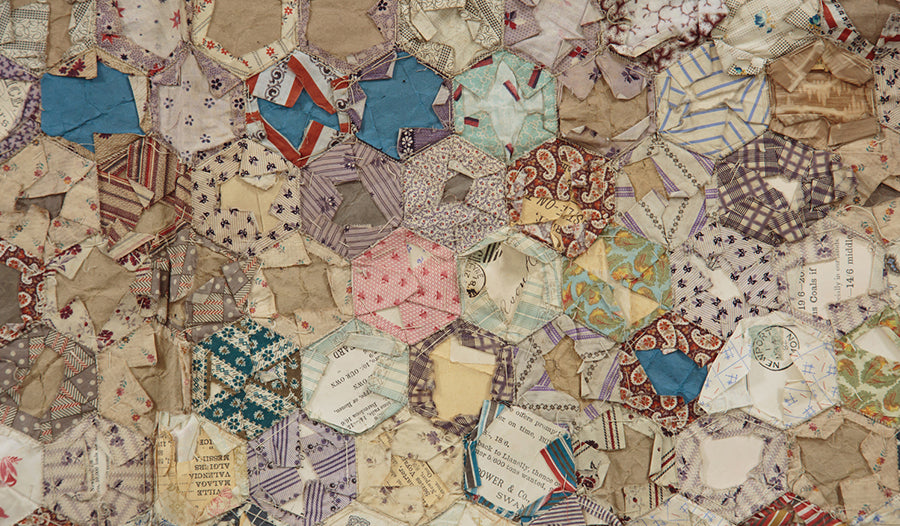
TEXTILE TRACES: ENGLISH PAPER PIECING

Creating atmospheric prints of pieced patchwork textiles allows artist Ruth Singer to preserve and record processes such as English paper piecing.
Highlighting the back, the workings, the humble innards of textile creations is integral to her thoughtful and emotional exploration of human experience expressed through textile making.
Pieced patchwork — English pieced patchwork in particular — offers her an intriguing opportunity to combine both paper text (used as the foundation templates) and textile elements. In English pieced patchwork, one can select salient scraps, offcuts and oddments, and combine them into a new whole, with text (or expression) carefully cut (edited) and then literally captured inside cloth.
Interview: In Conversation event for the opening of Ruth Singer's solo exhibition Textile Traces with Polly Leonard, founder of Selvedge.
In the early days of English pieced patchwork, the paper itself was an expensive commodity, which was created from textile rags (paper only became more affordable after the 1860s with the introduction of wood pulp), hence its careful repurposing into these laborious artefacts. Three hundred years ago, piecing over paper would have been very much a lady’s luxurious leisure pursuit. But the subsequent history of the craft, from the appearance of the first printed hexagon in Godey’s Lady’s Book in the 1830s, to the 1930s revival, and the appearance of pre-cut patchwork packs in 1970s Laura Ashley shops, is a story of increasing democratisation.

Image: Ruth Singer, Patchwork Prints (detail), 2017
Singer records the meticulous English pieced patchwork process in her Patchwork Prints series (2017). These monoprints on paper with handstitched details were part of her continuing research into ways to record textile processes. She sees print as a way to take a record of the patchwork with tacking and papers still in place, and the use of sepia ink gives the prints the feel of an x-ray. Details of loose threads, weave and paper texture invite a greater level of scrutiny.
 Image: Ruth Singer, Patchwork Prints (detail), 2017
Image: Ruth Singer, Patchwork Prints (detail), 2017
Singer often revels in highlighting the back, the workings, the wrong side, the technical, the humble innards of textile creations. This can be seen in her Sewn Up quilt series (2011-13) where she turned the proof pages of one of her early books into a quilt. The first quilt incorporated 665 folded squares, with no textile portions at all. This is a rather brilliant ultimate extension of the protracted English pieced patchwork process where only the resonant and stabilising personal paperwork remains.
 Image: Ruth Singer, Sewn Up (detail), 2017
Image: Ruth Singer, Sewn Up (detail), 2017
‘How does one fit these pieces back together?’ seems to be a fundamental question posed by much of Singer’s work, which examines emotional aftermath. And as little scraps of distress are shaped, folded, and given sharp, precise, intentional edges, some comforting order is restored where the vertices meet. An emotional turmoil – which might otherwise threaten to engulf or overwhelm – is somehow processed, regulated and neatly contained within those determined folds.
Extract from the exhibition review of Ruth Singer's work, Textile Traces: Personal Stories in Cloth, written by Eirlys Penn in Issue 89 Latin.

Are you interested in learning this historical quilting technique that can be traced back to 1770? Both delightfully intricate and easily portable, English paper piecing is a unique quilting technique that requires a great level of precision to result in geometric perfection.
Don't let that put you off though! We're delighted that Alice Caroline will be guiding participants through the technique in our upcoming workshop to create their very own star cushion.
Find out more here:


2 comments
I was so interested in this article as throughout my ‘patchwork life’ I always have a paper backed project on the go. It is becoming more difficult with arthritis in my hands ( I am 79 years old so is it any wonder?). I did all the Laura Ashley years making hexagonal quilts! Moved on to using different shapes using Liberty Tana Lawn and made six baby quilts one each o for my own grand children and in latter years have mainly made nine patch quilts with cut 1 and a half inch squares from silk ties using ties worn by my husband during his 30 year plus career as a teacher. That one was the largest I made and took me from January 2003 to September 2008 to complete. I chickened out on the quilting which was done professionally by the Bramble Patch in Weedon Northants That one used 97 of his ties and is 15×15 nine patch blocks. When the own tie supply ran out, I have frequented charity shops for them and have made many more smaller quilts and cushion covers since. Currently making a quilt for a wedding gift which is 9×11 nine patches. I use old calendars for the backing paper. The sheen from using silk ties makes them look like stained glass windows. From here to eternity!!
I have a small quilt made in 1810 which has motifs created from hexagonal shapes which are then appliquéd onto a backing piece. I was so interested to read about the cost of paper at this time as this quilt was made by my ancestor who was a housekeeper and possibly wouldn’t be able to afford paper. It has set me wondering …..
I’ve tried to attach a photo but failed I’m afraid!